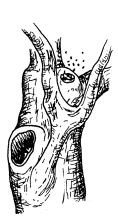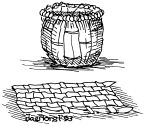


Aboriginal Plant Use Student Guide P
Plant activities
1. River Red Gum….a supermarket

RIVER
Match the animal to its tree home.
(a) Possum round hole on kiosk side of trunk
Bee large hollow in middle of trunk

Parrots hole near the fork of the tree
(b) Crush a fallen gum leaf. Smell it.
Why does it act like a medicine ? ________________________
(c) The long, bark scar near the base of the trunk is ____ metres long.
(d) How were strips of long bark used near the River Murray ? ___________
2. Yacca….fire sticks

(a) Yacca sticks float. Ngarrindjeri people tied them together near lakes and used them as _____________
(b) Use the drawing and plant to match the following:
Nectar resin from trunks
Glue flowers
Fire-stick flower stem
(c) What hunting weapon can be made from the Yacca stem? ______________
3. Ribbon Gum….peanut butter tucker P

(a) Without counting, I guess there are: more than 15 / less than 15 / exactly 15
holes in this tree.
(b) _____________________ live in the holes in the trunk.
(c) How could Aboriginal people get them out ?
4. Hollow Tree…home sweet home

(a) What was used to create this home ? ___________
(b) How do you know ? _____________________
(c) How did Kaurna people enlarge this shelter to make it more comfortable to live in ?
________________________________________
5. Queensland Nut Tree ….nutritious nuts

Look for brown nuts on the ground. Special nutting stones were used to crack the hard shells without squashing the delicious, creamy kernel inside.
(a) Circle the best Macadamia nutting stone.
6. Parapara….a sticky bird trap

Look for ribbed pods on this tree.
(a) These pods feel ______________
(b) Use the sketch to explain how Parapara pods
were used to trap ground feeding, rainforest birds.
7. Bottle Tree….thirst quencher

Tap the trunk of this tree.
(a) What might be inside ? ____________________
(b) How could you get it out ? ________________________
(c) What implement could be made from the soft bark of this tree ? ____________
8. Illawarra Plum ….double header

Look for a type of fruit on the tree.
(a) What is unusual about the fruit ? ________________________
(b) Why is it called a ‘plum’ ? _________
(c) Add ‘fruit’ to the drawing of the leaves. 
9. Fish Killer

Crushed bark from the Barringtonia tree was thrown into water-holes. 
(a) How did this help to catch fish ?
______________________
(b) Could there be a problem eating fish caught this way ?
10. Spear Lily….bird tucker

(a) How did this plant help hunters to trap birds ?
_____________________
(b) Why are the leaves good for making mats and baskets ?
___________________________________ 
(Hint: look at the ends of some old leaves)
11. Bunya Pine……picnic time

The cones of the Bunya Pine contain large, edible seeds. Aboriginal women climbed these trees to collect the seeds. ![]()
What made this a difficult job ? ![]()
12. Flax Lily…..all tied up

The stems of this plant are / are not flexible.
(a) String could be used for: _____________________________
13. Casuarina…..hardware tools

(a) Apart from sharp, what are three words
to describe the shape of a spear ?
_________ ________ ________
(b) Find a young tree in this forest that would make a good spear.
(c) Find a large Casuarina.
Circle on the drawing the part of the tree that would
be good for making a boomerang.
